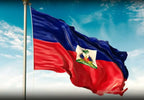
Haiti Flag: Meaning, Colors, and Why It Represents Resilience
, by Seo Guy , 3 min reading time

, by Seo Guy , 3 min reading time
The Haiti flag—two bold horizontal bands of blue and red framing a central emblem—has carried a nation’s story for more than two centuries. To grasp the full Haiti flag meaning, look closely at how color and crest work together. Blue evokes the unity of the Haitian people; red recalls courage and sacrifice. Centered between them is the Haiti coat of arms, set on a white panel: a palm tree crowned with a liberty cap, flanked by flags, cannons, drums, and anchors, all gathered beneath the motto “L’Union Fait La Force” (Unity Makes Strength).
Popular tradition holds that revolutionaries removed the white from the French tricolor in 1803, combining blue and red to signal a break from colonial rule. Whether told in classrooms or kitchens abroad, that origin story continues to shape the Haiti flag meaning today. The flag is not only a historical artifact; it is a living emblem of resilience, asserting that a people once enslaved claimed sovereignty and built the world’s first Black republic.
The Haiti coat of arms delivers a layered message. The palm tree suggests growth and rootedness; the liberty cap announces freedom; the cannons and flags embody defense and national pride. Drums, anchors, and weapons point to culture, trade, and the hard-won right to self-determine. When Haitians wear the crest on shirts or hang it in homes, they express the Haiti flag meaning in everyday life.
Each year on Haitian Flag Day, streets, schoolyards, and living rooms fill with blue and red. In Haiti, parades and assemblies revisit the flag’s history; in the diaspora, community centers host cultural programs, choirs, and storytelling hours for kids. Haitian Flag Day is more than an event—it is the annual rehearsal of the Haiti flag meaning, a reminder that unity grows stronger when it is celebrated together.
For families abroad, the Haiti flag becomes a teaching tool. Parents explain the palm and liberty cap, the drums and cannons, and the motto that ties it all together. Teachers create projects around Haitian Flag Day, and youth groups explore how the Haiti coat of arms connects to migration, language, and music. In these moments, the Haiti flag meaning turns into shared vocabulary and pride.
The Haiti flag endures because it compresses history, identity, and aspiration into a simple, recognizable image. From civic ceremonies to Sunday cookouts, it signals that unity is possible and dignity is non-negotiable. As long as communities keep explaining the Haiti coat of arms, honoring Haitian Flag Day, and revisiting the layered Haiti flag meaning, the banner will keep doing what it has always done—gather a people under one resilient sign.